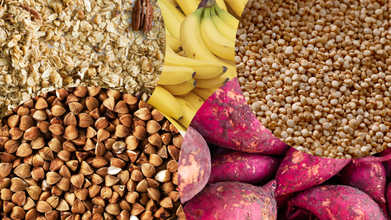- Health Conditions A-Z
- Health & Wellness
- Nutrition
- Fitness
- Health News
- Ayurveda
- Videos
- Medicine A-Z
- Parenting
Are All Carbs Bad? Here Are 5 Healthy Carbs You Can Try

Credits: Canva
For years, people have been scared of carbohydrates. It is seen as the 'No-No' in the food world. Wherever you look round, if you want to lose weight, or get fit, you are often told to not consume carbohydrates.
The term carbohydrate itself has been cast as the villain of the nutrition world. Many popular diets and fitness trends often link them to weight gain, type 2 diabetes, and a host of chronic conditions. But nutrition experts stress that not all carbs are created equal.
While heavily processed foods loaded with sugar and refined flour do raise health concerns, there are many carbohydrate-rich foods are nutrient-dense, fiber-packed, and highly beneficial for overall well-being. In fact, they are healthy and even recommended. Often in the garb of what social media tells us, we miss them out. You would be shocked to know that some of the healthiest staples in our diets, from whole grains to tubers and fruits, fall into the high-carb category.
Here’s a closer look at five high-carb foods that not only provide energy but also deliver significant nutritional value.
Quinoa
Quinoa, often mistaken for a grain, is actually a seed classified as a pseudocereal. Over the past decade, it has become a star ingredient in health-conscious kitchens worldwide.
Cooked quinoa is about 70% carbohydrate, but its nutritional profile goes far beyond carbs. It offers a balanced combination of fiber, protein, and essential minerals. Studies link quinoa consumption to better blood sugar management and improved heart health, thanks to its abundance of plant compounds and antioxidants.
Another major advantage? Quinoa is naturally gluten-free, making it a popular alternative for those with wheat sensitivities. Its high fiber and protein content also make it particularly filling, which can support both weight management and digestive health.
Oats
Few foods embody the phrase “comfort and health” quite like oats. Known as one of the healthiest whole grains, oats deliver a rich blend of vitamins, minerals, and antioxidants.
Raw oats are about 70% carbohydrate, with a single cup providing 54 grams of carbs—including 8 grams of fiber. Of special note is beta-glucan, a type of soluble fiber unique to oats that has been extensively studied for its heart-protective effects.
Research shows that eating oats regularly can lower cholesterol levels, reduce the risk of heart disease, and help manage blood sugar—particularly in people with type 2 diabetes. They’re also more protein-rich than most other grains, and their satiating quality makes them an excellent choice for weight management.
Buckwheat
Despite its name, buckwheat has no relation to wheat and is entirely gluten-free. Like quinoa, it belongs to the pseudocereal family and offers a nutritional punch that rivals traditional grains.
Raw buckwheat contains 75 grams of carbohydrates per 100 grams, while cooked groats contain nearly 20 grams. Beyond its carb content, buckwheat is rich in protein, fiber, and an impressive array of antioxidants and minerals.
Early studies suggest it may support heart health by improving blood pressure and cholesterol levels, as well as aiding blood sugar control, an especially valuable benefit for people at risk of diabetes. Its versatility in both sweet and savory dishes also makes it a practical choice for everyday meals.
Bananas
Bananas have long been a go-to snack for athletes, children, and anyone in need of quick energy. A large banana provides about 31 grams of carbohydrates, primarily from natural sugars and starch.
But bananas aren’t just about energy. They’re packed with potassium, vitamin C, and vitamin B6, along with helpful plant compounds. High potassium levels are particularly beneficial for heart health, helping to regulate blood pressure and support proper muscle and nerve function.
Interestingly, the ripeness of a banana changes its nutritional makeup. Green, unripe bananas contain more resistant starch, a type of carbohydrate that acts like fiber, feeding beneficial gut bacteria and supporting digestive health. As bananas ripen, starch turns into natural sugars, making them sweeter but less fibrous. Both versions, however, have health benefits.
Sweet Potatoes
Vibrant, versatile, and naturally sweet, sweet potatoes are another carbohydrate-rich food with outstanding nutritional value. A half-cup serving of cooked sweet potatoes with skin provides about 21 grams of carbohydrates, along with fiber, sugar, and starch.
They also contain key vitamins and minerals, particularly vitamin A (in the form of beta-carotene), vitamin C, and potassium. These nutrients play essential roles in vision, immunity, and overall cell health.
Perhaps most impressive, sweet potatoes are loaded with antioxidants—compounds that fight free radicals and may reduce the risk of chronic diseases like cancer and cardiovascular conditions. Their natural sweetness also makes them a healthier alternative to refined carb-based desserts or snacks.
Should You Rethink What Carbs Mean?
The bad reputation surrounding carbohydrates often overlooks a crucial fact: carbs are the body’s primary source of energy. What matters most is the type of carbs consumed. Refined, sugar-laden options offer little nutrition, while whole-food sources like quinoa, oats, buckwheat, bananas, and sweet potatoes deliver fiber, vitamins, minerals, and powerful antioxidants.
For most people, there’s no need to shun high-carb foods. Instead, the focus should be on choosing unprocessed, nutrient-dense varieties that nourish the body while providing steady energy.
As nutrition experts continue to emphasize, balance and quality, not restriction, are the true keys to a healthy diet.
Top-Ranked Diets Of 2025 That Gained Widespread Popularity

Credits: Canva
Whether your goal is to care for your heart, manage your weight or follow a steadier eating routine, finding the right diet can play an important role in supporting your overall well-being. The food you choose becomes your body’s fuel, so getting the right mix of nutrients matters. With so many eating plans available today, it can be hard to know which ones stand out.
Listed below are the nine diets that earned the strongest average ratings. However, speak with your doctor before beginning any new eating plan.
Best Diets of 2025, According to Nutrition Experts
In 2025, several diets gained popularity and were the most searched on the internet:
Mediterranean Diet
The Mediterranean diet is rooted in plant foods such as vegetables, fruits, whole grains, legumes, nuts and olive oil, with moderate portions of fish, poultry, eggs and dairy. It recommends keeping red meat and processed foods to a minimum and is often viewed as a long-term lifestyle choice that includes regular activity and shared meals. This way of eating has been linked to many benefits, especially for heart health.
Research shows the MIND (Mediterranean-DASH Intervention for Neurodegenerative Delay) diet slows age-related cognitive decline. Other work suggests that the MIND diet supports better brain function even when typical age-related changes are present, hinting at its role in helping older adults stay mentally resilient. Lesli Bonci, Director of Sports Medicine Nutrition at the University of Pittsburgh Medical Center, points out that some of the foods highlighted in this plan may feel expensive for certain households, though she praises the diet for what it may offer the brain.
DASH Diet
The DASH (Dietary Approaches to Stop Hypertension) diet is an eating pattern created to help reduce blood pressure. It focuses on fruits, vegetables, whole grains, low-fat dairy, lean protein and nuts, while limiting items high in saturated fat, cholesterol and sodium. The plan advises keeping sodium to 2,300 mg per day, or 1,500 mg for a stricter reduction. It also includes potassium, magnesium and calcium, which play a role in blood pressure control.
The DASH diet was built with heart health as its main goal. Its low-sodium approach has been studied widely, and the findings show that the diet can lower blood pressure and reduce “bad” LDL cholesterol. Followers use a chart to estimate their calorie needs, which then guides their daily servings from each food group. Leslie Bonci, a registered dietitian, board-certified specialist in sports nutrition and member of the Forbes Health Advisory Board, notes that the plan is effective for managing blood pressure, though its focus on produce may make it costlier for some people.
Flexitarian Diet
A flexitarian diet is mostly vegetarian but leaves space for occasional servings of meat or fish. The term blends “flexible” and “vegetarian” and encourages plant foods such as fruits, vegetables, legumes and whole grains, with meat limited to a few times each week or less. It offers a relaxed structure and is often chosen for its possible health and environmental advantages, including weight control and lower risk of certain diseases.
For those who hope to follow a plant-led eating pattern without giving up all animal foods, the flexitarian diet can be a comfortable starting point. The International Food Information Council describes it as a “semi-vegetarian, plant-forward diet” that features fruits, vegetables, legumes, dairy and eggs, with smaller or less frequent servings of meat. Early research indicates that this style of eating may support weight control and reduce the risk of heart disease and diabetes.
Pescatarian Diet
A pescatarian diet follows a vegetarian base but includes fish and seafood while avoiding red meat and poultry. It centers on plant-based foods such as fruits, vegetables, grains and legumes, with seafood added for protein and omega-3 fats. Some pescatarians also choose to include eggs and dairy, depending on personal preference.
Another branch of vegetarian eating, the pescatarian diet earned high scores for its simplicity and safety. A 2020 study showed that pescatarians had lower rates of obesity and were less likely to have cardiovascular risk factors such as high BMI, high blood pressure and high cholesterol. “The eating plan is broad and allows for variety, but one must like fish!” says Lesli Bonci, as per Forbes.
MIND Diet
The MIND diet blends key parts of the Mediterranean and DASH approaches, with the goal of supporting long-term brain health and lowering the risk of conditions such as Alzheimer’s. It encourages regular intake of leafy greens, assorted vegetables, berries, nuts, whole grains, fish, poultry, and olive oil, while advising people to cut back on red meat, sugary foods, butter, cheese, and fried dishes. Its foundation rests on simple, plant-focused eating patterns linked with better protection against age-related cognitive decline.
Studies show that this eating pattern can slow the rate at which memory and thinking skills weaken over time. Research also suggests that people who follow the MIND diet often perform better on cognitive tests, even when age-related changes are present in the brain, which points to stronger resilience. Bonci adds that some of the recommended foods may be costly for certain households, though she supports the diet for its strong potential to aid brain health.
Orange Juice For Heart? A New Study Reveals Why It Is Great For Cardiovascular Health

Credits: iStock
If you like orange juice and drink it daily for your breakfast, you are good to go. But, if you are someone who does not drink orange juice, you may want to reconsider your food habits. Scientists found that that orange juice could actually extend your healthy life and benefit your cardiovascular health.
The study published in Wiley Online Library revealed that orange juice consumption could influence the activity of thousands of genes inside our immune cell. Many of these genes also control blood pressure, calm inflammation and manage the way the body processes sugar. All these functions play an important role for long-term heart health.
How Was The Study Conducted?
The study followed adults who drank 500ml of pure pasteurized orange juice everyday for two months. After a period of two months, many genes that leads to inflammation and higher blood pressure had become less active.
What Were These Genes? These included NAMPT, IL6, IL1B, and NLRP3. These genes switch on when the body is under stress. There is another gene called SGK1 that impacts kidneys ability to hold onto sodium or salt, which also became less active. These changes have also matched a previous findings that showed daily orange juice consumption could also reduce blood pressure. Orange juice contains hesperidin, a flavonoid that could help lower blood pressure. There are antioxidants too that are great for overall heart health.
What About The Blood Sugar Levels?
The trials have shown that orange juice does not simple raise blood sugar levels, instead, it triggers small shifts in the body's regulatory system that could reduce inflammation and also help blood vessels relax.
However, what is important to note is that hesperidin that influences the genes have varied response based on a person's body size. So, people who weigh more could show greater changes in gene, which also involves fat metabolism, while leaner people could show stronger effects on inflammation.
Orange And Heart Health
A systematic review from 2021, published in the journal Phytotherapy Research that involved 639 participants from 15 different studies also found that regular orange juice consumption lowered insulin resistance and blood cholesterol levels. Insulin resistance is what leads to diabetes, as it is the precursor for pre-diabetes, and high cholesterol is linked with heart diseases.
Another 2022 study published in journal Food & Function showed that overweight and obese adults noticed small reduction in systolic blood pressure and increase in high-density lipoprotein or HDL, which is also known as the 'good cholesterol'. This result was achieved only after several weeks of orange juice consumption. While these changes were modest, the improvements could make a greater difference, if the same food habits are maintained for years.
More answers come from looking at metabolites, the tiny molecules our bodies make while breaking down food. A recent review found that orange juice can influence several key pathways, including how we use energy, how our cells communicate, and how the body manages inflammation. It may even shape the gut microbiome, which experts now know plays a big role in heart health.
Furthermore, a 2023 study published in the journal Frontiers In Microbiology noted that people who drank blood orange juice daily for a month saw an increase in gut bacteria that produce short-chain fatty acids, compounds known to support healthy blood pressure and lower inflammation. These volunteers also showed better blood sugar control and reduced levels of inflammatory markers, hinting that the benefits of orange juice may go far beyond its refreshing taste.
Punjab Worst Hit By High Uranium Levels In India’s Groundwater; Raise Health Concerns

Credits: iStock
The latest Annual Ground Water Quality Report 2025 by the Central Ground Water Board (CGWB) has delivered a worrying revelation: Punjab now records the highest intensity of uranium contamination ever reported in India, with 62.5% of groundwater samples exceeding the safe limit post-monsoon. This is followed by Haryana, Delhi, Karnataka and Uttar Pradesh, indicating a dangerous pattern across north and north-central India.
While nitrate and fluoride remain more widespread contaminants, uranium’s increasing presence raises an urgent public health concern because even low-dose, long-term exposure can quietly harm vital organs.
Where Is Uranium Contamination Rising?
The CGWB tested 3,754 groundwater samples across India in pre- and post-monsoon seasons. The findings show a clear upward trend:
Nationally, uranium exceedance rose from 6.71% (pre-monsoon) to 7.91% (post-monsoon).
Punjab recorded the highest contamination:
- 53.04% pre-monsoon
- 62.50% post-monsoon
Haryana followed with 15–23.75% of samples above limits.
- Delhi: 13–15.66%
- Karnataka: 6–8%
- Uttar Pradesh: 5–6%
The report highlights northwestern India: Punjab, Haryana, Delhi, and parts of Rajasthan and Uttar Pradesh — as the main hotspot, likely due to geogenic factors, aquifer depletion, and intense groundwater extraction. Meanwhile, eastern and southern states reported minimal contamination.
Why Uranium in Water Is Dangerous
According to the 2025 study “Uranium’s hazardous effects on humans and recent developments in treatment,” the real threat from uranium lies in its chemical toxicity, not its radioactivity.
Kidney Damage: The Most Significant Risk
Uranium behaves like a heavy metal that gets absorbed and stored in the kidneys, impairing their ability to filter waste.
This can lead to:
- Proteinuria (excess protein in urine)
- Reduced kidney function
- Long-term kidney diseases
Even low-dose, chronic exposure through drinking water can gradually weaken renal functioning.
Respiratory Harm and Lung Cancer Risk
People who inhale uranium particles — especially workers in mining or processing — face:
- Chronic respiratory irritation
- Persistent coughing
- Higher risk of lung cancer, particularly due to radon gas produced as uranium decays
Gastrointestinal Entry and Toxic Build-Up
Recent findings note that the gastrointestinal system is the main route of uranium entry. Once consumed through contaminated water, uranium moves from the stomach and intestines into soft tissues and organs.
Bone Accumulation and Cancer Risk
Because uranium is a chemical analog of calcium, it can get deposited into bones. Over time, this raises the risk of bone cancer and may interfere with normal bone cell functioning.
Possible Reproductive and Developmental Effects
Animal studies suggest:
- Potential risks of congenital disabilities
- Effects on reproductive organs
- But direct evidence in humans remains incomplete, calling for more research.
Neurological and Immune Effects Being Explored
Some studies hint at:
- Behavioral changes
- Cognitive deficits
- Unclear impacts on the immune system
These areas remain under-studied but concerning.
Why India Must Worry Now
The CGWB report warns that while most groundwater in India remains safe, the pockets of rising uranium contamination require immediate monitoring and mitigation. With millions relying on groundwater for daily consumption, even a small rise in toxic metals can translate into widespread health damage over time.
Long-term exposure rarely shows immediate symptoms, which makes the threat quiet but deeply harmful.
© 2024 Bennett, Coleman & Company Limited

